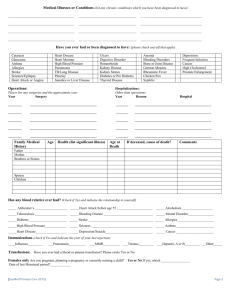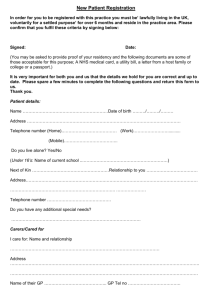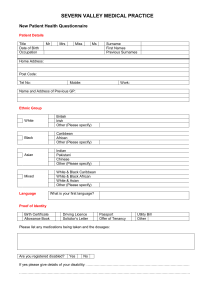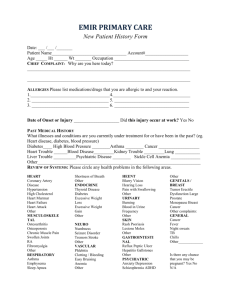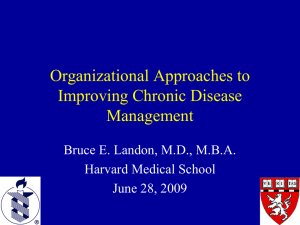A Meta-Analysis of Interventions to Improve Chronic Illness Care Alexander Tsai
advertisement
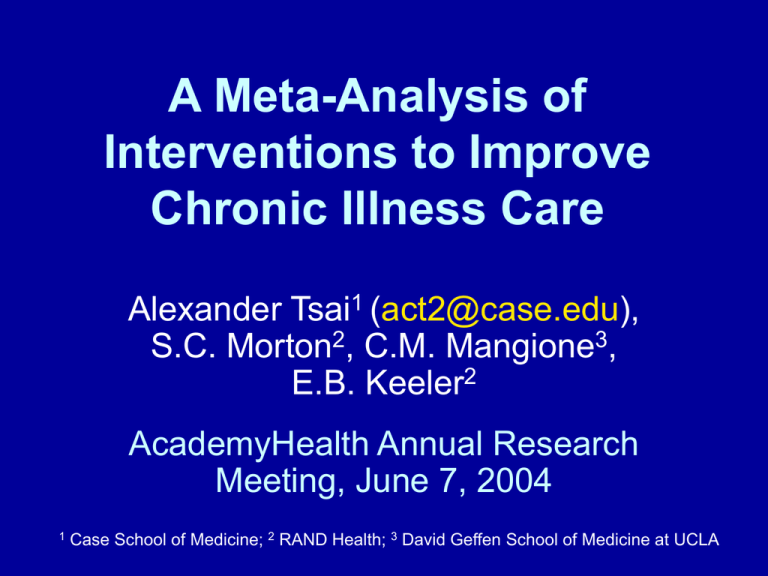
A Meta-Analysis of Interventions to Improve Chronic Illness Care Alexander Tsai1 (act2@case.edu), S.C. Morton2, C.M. Mangione3, E.B. Keeler2 AcademyHealth Annual Research Meeting, June 7, 2004 1 Case School of Medicine; 2 RAND Health; 3 David Geffen School of Medicine at UCLA The Chronic Care Model Objective • Lack of controlled studies of the CCM – But there have been controlled studies of interventions that incorporate one or more CCM elements • Using meta analysis, we sought to: – Determine the extent to which CCM-style interventions improve chronic illness care – Determine whether any specific CCM elements were essential to improved outcomes Table 1. Outcomes of Interest Clinical Outcomes (Continuous) (Dichotomous) Quality of Life Processes (Continuous) (Dichotomous) Asthma # ED visits % with at least one ED visit Quality of life % with longacting meds CHF # hospital readmissions % with at least 1 readmission Quality of life % with ACE inhibitor Depression Depression Scale % depressed /symptomatic Quality of life or SF-36 MCS % with antidepressant Diabetes % with HbA1c Quality of life > 7% HbA1c % tested for HbA1c level Data Sources 1. Bibliographies of 23 recently published systematic reviews and meta-analyses: asthma (5), CHF (6), diabetes (7), depression (2), general chronic care (2), information systems (1) 2. MEDLINE 1998-2003 3. Chronic Care Bibliography Inclusion/Exclusion Criteria • Inclusion criteria – 1993-2003 – Asthma, CHF, depression, diabetes – Controlled (randomized or non-randomized) – Outcomes of Interest • Exclusion criteria – Not written in English – Non-adult patient population – Insufficient statistics Data Abstraction • Data obtained from all relevant associated articles and attributed to the primary citation • Only 12-month follow-up data recorded if multiple follow-up times assessed • If missing data, SD conservatively assumed to be 1/4 of the theoretical range for that measure Statistical Analysis • Comparisons at follow-up • Pooled analysis by condition – Hedges’ g (continuous), risk ratio (binary) • Relative effectiveness of CCM elements – Random-effects meta-regression model • Funnel plots to detect publication bias • Cochran’s Q to assess heterogeneity • Sensitivity analysis for Jadad score ≥3 Table 2. Summary Statistics (N=112) Element Type DSD SMS DS CIS 19 CR 4 HCO 6 N 60 80 38 # Elements One Two Three Four Five Six N 52 33 19 8 0 0 Jadad score Zero One Two Three Four Five N 19 23 34 36 0 0 Table 3. By Condition Clinical Outcomes Quality of life Processes [continuous] (lower=better) [dichotomous] (lower=better) [continuous] (higher=better) [dichotomous] (higher=better) Effect Size RR Effect Size RR -0.23 * 0.84 * 0.11 * 1.19 * Asthma 0.82 * 0.01 1.61 CHF 0.81 * 0.28 * 1.13 * OVERALL Depression -0.25 * 0.83 * 0.18 * 1.28 * Diabetes -0.19 * 0.92 -0.02 1.10 * * P<0.05 Table 4. By CCM Element Clinical Outcomes Quality of life Processes [continuous] (lower=better) [dichotomous] (lower=better) [continuous] (higher=better) [dichotomous] (higher=better) Effect Size RR Effect Size RR DSD -0.21 * 0.77 * 0.33 1.16 * SMS -0.22 * 0.81 * -0.03 1.31 * DS -0.14 0.87 0.04 1.29 * CIS -0.06 0.83 -0.28 1.08 * P<0.05 Conclusions 1. Interventions that contained one or more CCM elements improved clinical outcomes and processes of care for four chronic illnesses 2. Effect on quality of life was mixed 3. The specific CCM elements most responsible for the beneficial effects could not be determined Limitations • Testing the CCM vs. testing CCM elements – Unable to assess intensity of implementation • Unexplained heterogeneity in aggregating across conditions and types of interventions • Conclusions limited to selected outcomes and selected conditions For additional information: http://www.rand.org/health/ICICE E-mail: act2@case.edu Fig 1. Clinical Outcomes (Continuous) Depression Diabetes Banerjee (1996) Barrett (2001) Blanchard (1995) Brown (2000) Callahan (1994) Coleman (1999) Datto (2003) Goldberg (1998) Hunkeler (2000) Katon (1995) Katon (1996) Katon (1999) Katzelnick (2000) Leveille (1998) Llewellyn-Jones (1 Mann (1998) Miranda (2003) Mynors-Wallis (200 Rabins (2000) Rollman (2002) Rost (2001) Rubenstein (2003) Simon (2000) Tutty (2000) Unutzer (2002) Whooley (2000) Worrall (1999) Benjamin (1999) Brown (2002) DICET (1994) De Sonnaville (199 Glasgow (2000) Glasgow (2003) Hirsch (2002) Hoskins (1993) Hurwitz (1993) Jaber (1996) Keyserling (2002) Kinmonth (1998) Laffel (1998) Meigs (2003) O'Connor (1996) Olivarius (2001) Pieber (1995) Piette (2000) Piette (2001) Ridgeway (1999) Stroebel (2002) Thompson (1999) Tu (1993) Weinberger (1995) Whitlock (2000) Combined -2 -1 0 Standardized effect size 1 Q=230, df=51, P<0.001 Pooled Effect Size = -0.23 (-0.31, -0.15) favoring intervention Fig 2. Clinical Outcomes (Binary) Asthma CHF Depression Diabetes Bailey (1999) Cowie (1997) Garrett (1994) Ghosh (1998) Harish (2001) Heard (1999) Yoon (1993) Capomolla (2002) Cline (1998) Ekman (1998) Harrison (2002) Hughes (2000) Jaarsma (1999) Kasper (2002) Laramee (2003) Naylor (1999) Philbin (2000) Rich (1993) Rich (1995) Riegel (2000) Riegel (2002) Schneider (1993) Serxner (1998) Stewart (1998) Stewart (1999) Weinberger (1996) Banerjee (1996) Katon (1999) Katzelnick (2000) Llewellyn-Jones (1 Mann (1998) Mynors-Wallis (200 Rollman (2002) Rubenstein (2003) Simon (2000) Tutty (2000) Unutzer (2002) Wells (2000) Whooley (2000) Williams (1999) De Sonnaville (199 Meigs (2003) Piette (2000) Renders (2001) Combined .25 .5 Relative risk 1 2 4 Q=135, df=45, P<0.001 Pooled RR = 0.84 (0.78, 0.90) favoring intervention Fig 3. Quality of Life Asthma Abdulwadud (1999) Blixen (2001) Cote (1997) De Oliveira (1999) Gallefoss (1999) Kauppinen (1998) Knoell (1998) Kotses (1995) Lahdensuo (1996) Levy (2000) Premaratne (1999) Thoonen (2003) Harrison (2002) CHF Jaarsma (1999) Kasper (2002) Philbin (2000) Rich (1995) Stewart (1999) Depression Rubenstein (2003) Unutzer (2002) Wells (2000) Diabetes Glasgow (2000) Kinmonth (1998) Piette (2000) Combined -2 -1 0 Standardized effect size 1 Q=93, df=23, P<0.001 Pooled Effect Size = 0.11 (0.02, 0.21) favoring intervention Fig 4. Processes of Care Asthma Eccles (2002) CHF Gallefoss (1999) Akosah (2002) Cline (1998) Gattis (1999) Kasper (2002) Philbin (2000) Depression Weinberger (1996) Aubert (2003) Bashir (2000) Brown (2000) Callahan (1994) Coleman (1999) Dowrick (1995) Katon (1999) Mann (1998) Rollman (2002) Rost (2001) Rubenstein (2003) Unutzer (2002) Weatherall (2000) Wells (2000) Diabetes Worrall (1999) Branger (1999) DICET (1994) Davidson (2000) Kiefe (2001) McDermott (2001) Meigs (2003) O'Connor (1996) Reed (2001) Stroebel (2002) Combined .25 .5 1 2 4 Relative risk Q=312, df=31, P<0.001 Pooled RR = 1.19 (1.10, 1.28) favoring intervention

